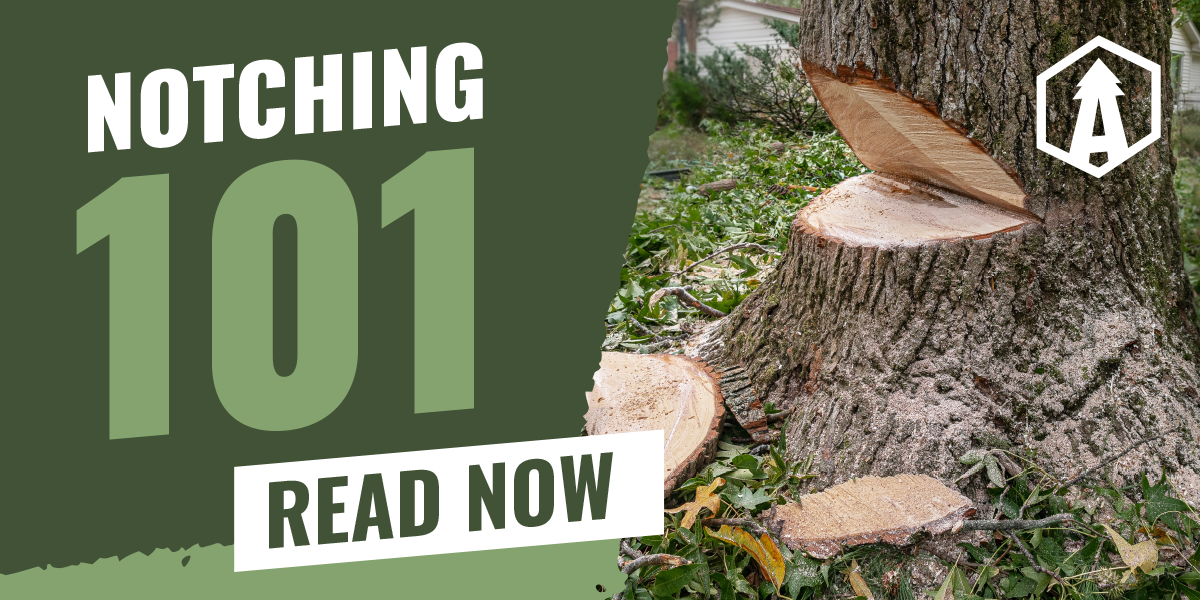
Just Drop it… A simple guide to notches!
Before we begin, felling trees can be a dangerous task and the best way to prepare is to educate oneself on the variables that come into play. For example, tree species. We all know that the fibers on an American Elm are very “stringy”, which for me personally, gave excellent hinge when I wanted to steer a tree as I felled it. Whether the tree is alive or dead also plays a role in how well you can control it and so does executing a perfect notch.
What is a notch?
Face cut, pie cut, directional cut; these may be a few ways people may refer to a notch as. However, a notch may be defined as making an opening via chainsaw into the spar of the tree by making an angled cut at a 45-degree along the top followed by making the bottom cut (traditional) and meeting at the apex of the notch. The point of the notch is to guide the tree into the direction the notch was made and given the tree species; steering the tree and when the hinge will break.
The Three Basic Notches.
The Traditional
Also known as the Conventional. Absolutely the most common notch you will come across. It is easy to perfect and gives the saw operator the ability to achieve accuracy… to a certain extent. However, to execute this notch, one must begin with the top 45-degree angle cut. But why?! Don’t worry, I thought the same thing too but once I began my journey as a trainer, I understood why it made sense to teach it this way. The top of most saws have a black bulging line on the body of the saw itself and that is called your felling sight. This sight is used to assist the saw operator in aiming the notch correctly.
-
So, we’ll grab the saw by the handle bar, at the point where the handle curves. Lock your arm downward (with the saw in your hand), press it against the tree and voila, you should have the perfect 45-degree angle. By starting here first, you reduce (if not, remove) the chances of cross cutting your notch.
-
Follow up by cutting one-third of the way into the tree. Through the years what I’ve found, this may depend on the diameter of the tree or depending on what action you want the spar to do.
-
Lastly, the bottom cut. Line up the bottom cut with the apex of the top cut and hold the saw as even as possible, avoid slanting the bar. Bigger saws and bars will require some finagling. DO NOT cross cut your notch apex! Doing that may destroy your hinge fibers and you might end up with a snap cut.
-
When you are ready to begin your back cut, it’s usually recommended at about one-to-two inches. The reasoning behind that is to create a step or a buffer, if you will, in hopes to prevent the log or tree from coming back at the user. However, different factors may still cause the it to bounce and spring so don’t assume it won’t happen.
The Humboldt notch.
Quick fact, this notch originated in Humboldt County, California and is widely used by loggers. You don’t even have to look at it too closely to realize this, it’s an upside-down Conventional notch. But why?!
-
First, things first; begin by doing the 45-degree angle cut here as well. Using the sight to help guide, if needed.
-
At this point we will follow with the top cut, the notch should just slide down on its own after the saw meets at the apex. Gravity is a big help here when felling those big nasties!
-
Begin the back cut at the recommended distance (1-2”) above the “top” cut.
-
An advantage with this notch is not having it potentially sit on the stump when the tree has hit the ground as the Conventional does. The Humboldt, when it’s on the way down, will still break off when the notch closes but the trunk will push off and fall to the ground. This can potentially eliminate the need for making risky cuts and having the tree twist as we begin to remove limbs under pressure.
The Open-Faced Notch.
When you need to control the tree as much as possible, the Open-Face is the go-to notch.
- As per the usual, begin with the top cut first. This one will vary slightly. Roughly begin your top cut at a 70-degree angle, you can do it a bit different as you see fit.
-
The bottom cut now comes in at a 30-degree angle. Yep, this is not going in flat. This notch can be a bit difficult to master if you can’t control the saw; also, DO NOT bypass on your notch.
-
The back cut here has to be dead even with the apex of the notch. This will ensure the wood fibers will react as they are suppose to.
-
The reason this notch gives the feller the most control lies within the hinge and how wide the opening is made. The other two notches have one thing in common; the tree will break off when the notch closes and once that happens, we lose control. The Open-Face does the opposite, the hinge will stay intact and most of the time it will not break off even after it’s hit the ground.
As mentioned before, these are the basic notches, and we are aware that there are others along with multiple factors that can dictate how felling operations will go. Just because you made the world’s best notch; doesn’t mean something can’t go wrong.

Leave a comment